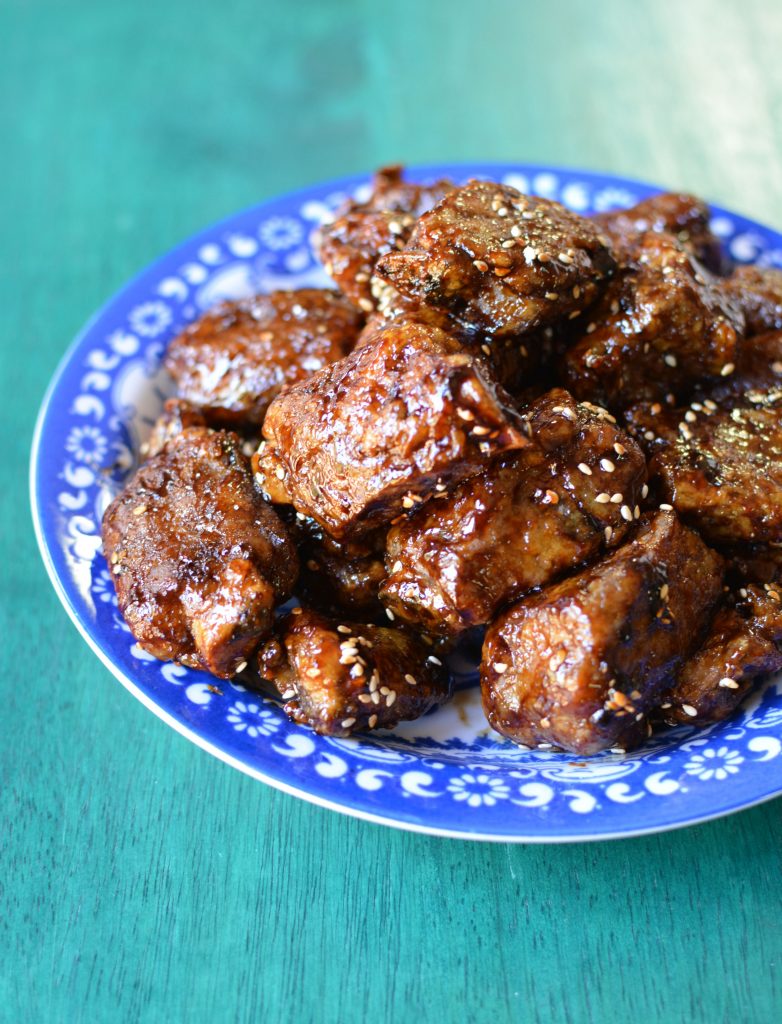
Chinese cooking is incredibly varied, which is why sweet and sour dishes are not all the same. For example, Cantonese-style sweet and sour pork with pineapple chunks and sweet-tangy sauce is different from Shanghai-style sweet and sour ribs (above), which are devoid of fruit and appear dark and lusty. The sweet and sour ribs look serious and gutsy but the flavor is actually very well balanced and not overly tangy.
You'd think that sweet and sour ribs are a la minute but they're actually great for make ahead eating because they benefit from cooling, during which they develop better flavor. They're finger food and are like barbecue with the coating of tangy sauce. I like them a lot.
In Mandarin, Shanghai-style sweet and sour ribs are called tang cu pai gu (糖醋排骨) and they’re traditionally simmered until tender, deep-fried and then tumbled in a sauce that’s similar to a red-cooked dish with sugar and soy sauce. The frying imparts a crisp exterior and toasty fragrance, but modern, healthy cooks often skip that step and just add the boiled ribs to the sauce and cook them until the sauce reduces and coats things nicely. A splash of vinegar brightens and finishes the dish.
I’ve been getting into air-frying lately, after talking to friends and colleagues like Ben Mims who just wrote an air-frying cookbook and then experimenting and trying out different models. The air-fryer got me thinking of ways to make healthier, easier renditions of my favorite deep-fried foods. The result of the air-frying meditation was four days of air-frying, which I wrote about in a Cooking Light magazine story.
As you’ll read in the article, I like the new generation of air-fryers that are designed like ovens, because after all, an air-fryer is basically an intense little convection oven. Among the ones I tried, the Cuisinart air-fryer oven stood out in terms of its performance (fast, even browning), versatility (it toasts, bakes and air-fries), and capacity (a decent amount of food can fit with little overlap). The only setbacks are the analog dials so you can’t program the temperature and time. Those are not deal breakers to me. I just set a separate timer.
There were rough patches in my air-frying adventures, for example, some very hard French fries, but it was fun and definitely low-calorie. Plus, cleanup was easy. Air-frying does not fully replicate deep-frying. It’s lean. Even if you put a ton of oil on the food, the oil will get knocked off during the cooking process.
Air-frying is like exposing food to a hot windstorm so you need some fat to coax things along or things will simply dry up. I found that out when I developed an air-fried General Tso’s chicken recipe for Cooking Light. The process isn’t pretty, because the crisp coating looks borderline moldy due to the cornstarch. But who cares if you’re going to coat the food in sauce?
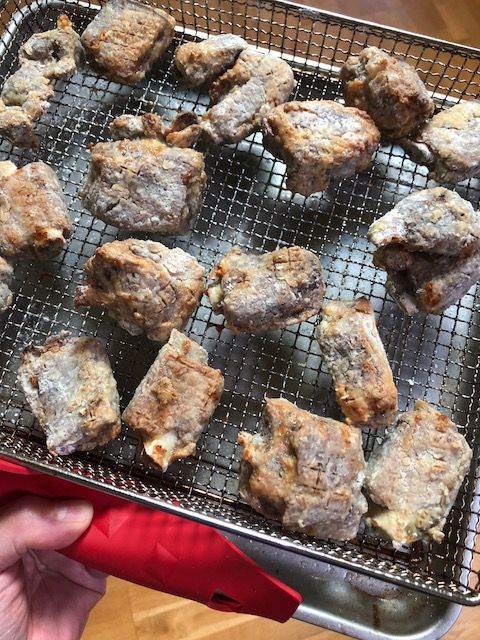
Last week, after making the Bourdain tribute wonton noodle soup, I had leftover ribs from the stock – a perfect excuse to experiment with sweet and sour spareribs. I love to order the dish at Shanghai restaurants but frankly they can be a gut bomb, given that one order is typically a giant pile of deep-fried ribs cloaked in sauce. Plus, we order a bunch of other dishes! Can I make a smaller, less greasy batch at home with relatively easy?
I used the leftover ribs from wonton soup stock making for my first test run but the ribs were overly cooked and not as porky tasting. On my second try, I cooked the ribs in the Instant Pot for 10 minutes at high pressure and with the depressurization time, they were just the right tender-chewy texture.
Because the air-frying process doesn’t submerge food in fat but rather exposes it to a hot windstorm, my cornstarch coating remained white in places. No biggie because the ribs would get coated in sauce at the end.
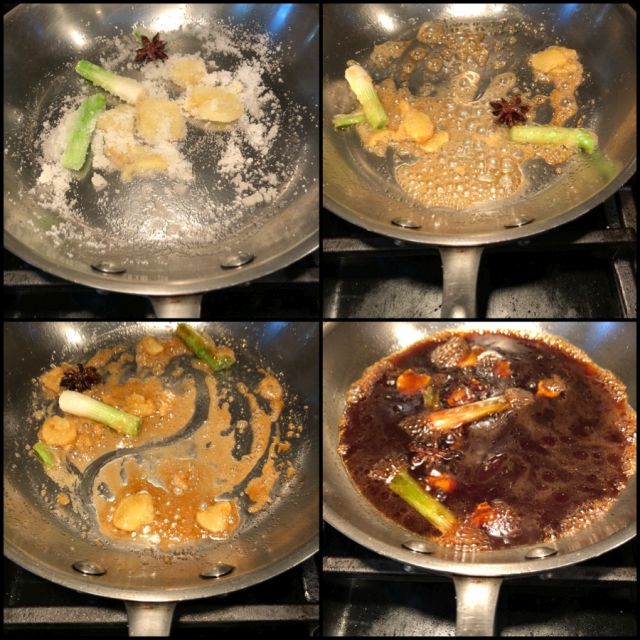
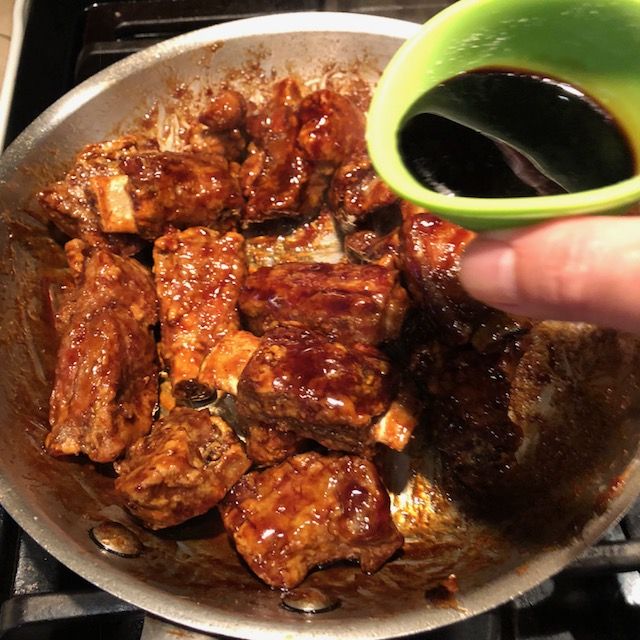
The rest was a matter of caramelizing sugar, adding liquid to create an umami rich seasoning liquid. Then the crisp ribs were added to the sauce and things cooked down and got coated. Slightly smoky Chinkiang vinegar (or a combo or balsamic and cider vinegar) finishes the sweet and sour ribs.
You can cook the ribs in advance, refrigerate them up to 3 days, then return them to room temperature to air-fry.
If you want to turn these Shanghai-style sweet and sour ribs into a Cantonese-style sweet and sour ribs, use the sauce in this terrific recipe.
Air-Fried Sweet and Sour Ribs Recipe
Yield 4 servings
Without an air-fryer you could deep-fry the rib. If you tumble them in oil and roast in a 450F oven, they may get overly dry -- but you can certainly try! Or, skip the frying step for a less crisp and less starchy, carby finish; one third cup of cornstarch may be a lot for you. If you have ribs from another recipe, like the wonton soup, skip to air-frying and saucing!
Ask your butcher to saw the ribs across the bone into narrow strips. You can serve 2 or 3 if you have the ribs as a main dish with other dishes. For 4 people, this recipe would be a snack.
Ingredients
- 2 pounds spareribs, cut across the bone into 2 to 3-inch strips
- ½ small yellow onion
- 1 inch ginger, cut into 4 or 5 slices and crushed
- 4 cups water
- 1 teaspoon fine sea salt
- 1 egg
- ⅓ cup cornstarch
- ¼ teaspoon Chinese five spice powder
- 1 ½ teaspoons sesame seeds
- Toast in skillet over medium heat
- 1 tablespoon oil
- 1 green onion, white parts only, halved crosswise and bruised
- Chubby 1-inch ginger, peeled cut into 4 slices, crushed
- 2 tablespoons sugar
- 1 Star anise (8 robust points)
- 1 tablespoon soy sauce
- 1 teaspoon dark soy sauce, or ½ teaspoon soy sauce plus ½ teaspoon molasses
- 1 ½ tablespoons Chinkiang vinegar or 1 tablespoon balsamic plus 1 ½ teaspoons apple cider vinegar
Instructions
- Cut the strips of ribs between the bones into individual riblets. Put the riblets, onion, ginger, water and ¾ teaspoon salt in a pressure cooker. Lock on the lid and bring to high pressure. Adjust the heat to maintain pressure and cook for 10 minutes, then naturally depressurize for 12 minutes. (Program a multicooker such as an Instant Pot or Fagor Duo to cook on high pressure for 10 minutes. Unplug or turn off the machine then let naturally depressurize for 15 minutes.) Regardless of machine, finish by releasing residual pressure. (Without a pressure cooker, simmer the ribs with 6 cups water for 1 ¼ to 1 ½ hours, until tender. Add water as needed to ensure the ribs remain covered.)
- Use tongs to transfer the riblets to a bowl. Add water to cover and let sit 1 to 2 minutes to cool. Drain and transfer to a rack set on a baking sheet to finish cooling for about 5 minutes, until lukewarm and relatively dry.
- Strain the cooking liquid from the pressure cooker. Measure out 1 cup for this recipe and use the remainder for another recipe, such as a soup!
- Beat the egg in a medium bowl. In a large bowl, stir together the cornstarch, five spice, and ¼ teaspoon salt. Spray or lightly oil the air-fryer rack. In 3 or 4 batches, coat the ribs in egg then dredge in cornstarch. Lightly pat to remove excess starch then put on the rack. Don’t let the ribs touch; you want to facilitate air circulation.
- Preheat the air-fryer to 400F for 3 minutes. Air-fry the ribs for 8 to 10 minutes, turning midway when there are some brown spots. They’ll be crisp with lingering white areas due to the cornstarch. Don’t worry.
- While the ribs air-fry, in a medium stainless-steel (or light interior) skillet over medium heat, toast the sesame seeds for 2 minutes, or until golden. Transfer to a small container. Warm the oil in the skillet over medium heat, then add the green onion, ginger, and star anise. Cook, stirring, for 1 minute, or until fragrant. Add the sugar, stir, and cook for 3 to 4 minutes, until it’s a rich caramel color.
- Slide the pan to a cool burner, let rest for 1 minute, then pour in the reserved rib cooking liquid, soy sauce, and dark soy sauce. Stir to combine, then bring to a boil. Let cook for 2 minutes to develop flavor, then strain and return the liquid to the pan (or use a slotted spoon to remove the solids).
- When the ribs are done, remove them from the air-fryer, let sit for 2 minutes to cool briefly. Return the seasoning liquid to a boil over medium-high heat, add the ribs, then cook, stirring constantly to get the reducing sauce to coat the ribs well. After about 2 minutes, when little free-flowing liquid remains, add the vinegar. Stir for about 1 minute longer to allow the ribs to absorb its tang.
- Sprinkle on the sesame seeds, turn to coat, then transfer the ribs to a plate. Let cool for 5 minutes to develop flavor before eating as finger food. The ribs are also good at room temperature.
Courses appetizer
Cuisine Chinese













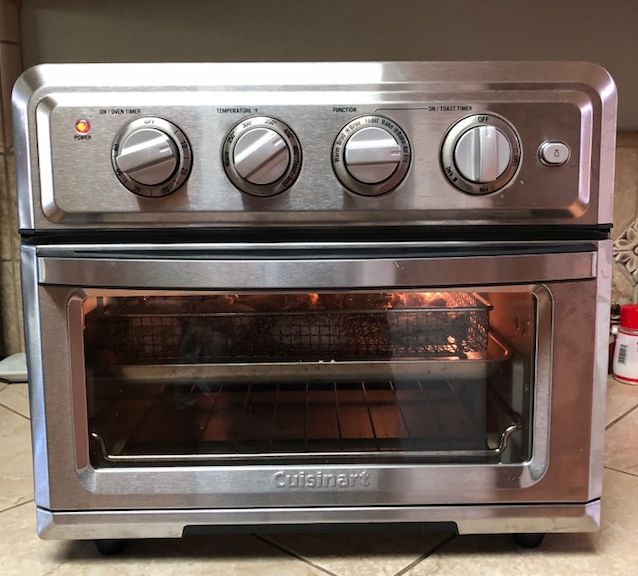
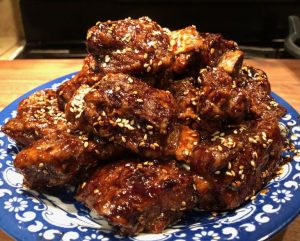




Catherine Oliver says
Most of the air fryers looked nothing like yours but then I saw that it's Cuisinart. And it's described as a toaster oven. Can it take the place of a toaster oven? I just can't justify another small appliance 🙂
https://www.wayfair.com/kitchen-tabletop/pdx/cuisinart-06-cu-ft-air-fryer-toaster-oven-cui3490.html
Andrea Nguyen says
The Cuisinart T0A60 is a toaster, oven, convection oven and air-fryer! It's like a tall toaster oven:
https://amzn.to/2IrnxEg
I've used it for regular toaster oven jobs, too.
Catherine Oliver says
Thanks, Andrea. Our toaster oven isn't anything to write home about. I should measure to make sure it would fit under the cabinet. Happy 4th.
Andrea Nguyen says
If you're looking for a compact toaster oven, I really like this Breville, which heats well and is digital. The price isn't outlandish for a Breville product, too.
https://amzn.to/2lXGF44